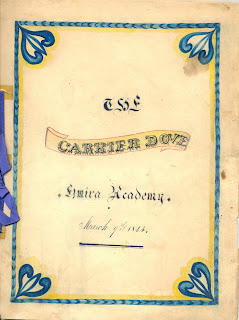by Erin Doane, curator
Drilling
for natural gas may seem like a modern issue in this region, but oil and gas
exploration and drilling have been going on here for well over a century. On
June 11, 1891 the Elmira Daily Gazette
and Free Press reported on oil being discovered in Wellsburg. “Everybody
who owns a piece of real estate in the village is laboring under a fever of
excitement,” wrote the reporter. “Real estate here is going up like a balloon
to-day.” The strike was entirely unexpected and did not herald a major boom as
some had hoped, but it is a fascinating bit of history.
 |
| Headline from Elmira Daily Gazette and Free Press, June 11, 1891 |
Charles
E. Van Buskirk moved to Wellsburg in 1879 where he went into business as a
furniture dealer and undertaker. His home was behind the Exchange Hotel located
on Front and Main Streets in the village. He needed a water well for his property
and hired T.J. Bardeen, an old well digger, to do the job. On June 11, Bardeen
started drilling. When Hiram W. Young had a new well drilled on his property
just two years earlier, they reached water at less than one hundred feet.
Young’s well was famous for being one of the finest artesian wells in the
county. Van Buskirk was perhaps hoping for similar results.
 |
| Exchange Hotel, Wellsburg, c. 1906 |
At
130 feet the drill began bringing up black and gray colored pigments that
smelled oily. Then, a dark colored substance that looked like crude oil, but
smelled like lubricating oil was bailed off. They had struck oil! Word of the
discovery spread quickly through the small village. A crowd gathered around the
well and started debating the find. The Gazette
reported that the substance in the well was, unmistakably, genuine crude oil.
As the drilling continued to a depth of 140 feet, oil was still coming up with
the refuse from the well. This convinced more than half the men in the village
that the well was a winner.
At
5:30pm that evening, however, drilling came to a halt. Van Buskirk informed the
gathered crowd that he could not afford to have the well drilled any deeper. It
cost $10 a day to keep drilling and, as it was, the oil had already spoiled his
water well. He was not going to invest any more time or money into the well
unless the townspeople provided some additional financial support. Bardeen, who
had been drilling the well, informed Van Buskirk that he had to pack up and
leave. If they came up with the money, Bardeen was willing to come back, rig up
a derrick, and work the well, but in the meantime he had other wells to drill
in Pine City.
There
was some skepticism about the oil find from the very beginning. Some people
believed that someone had dumped oil down the well to make it look like a
genuine strike. The Elmira Telegram
published a small paragraph about the well on June 14, 1891 on the same page as
funeral, ice cream social, and personal travel notices. The somewhat snarky
report reads in part:
There are some people who think the hole was
greased and others who think the wind blew through the drillers whiskers. The
TELEGRAM hopes the discovery may prove genuine, but still there’s reasonable
ground for doubts. If someone will pull the hole up and send it to an oil
expert for examination, the TELEGRAM will publish the report in full.
Steve
Herman, one of Wellsburg’s solid citizens, however, was said to have been
keeping a close watch on the well the entire time and was sure that no funny
business had taken place.
 |
| Article from Elmira Telegram, June 14, 1891 |
Despite
the controversy, $50 was raised and drilling continued. At a depth of 187 feet,
a small amount of natural gas was detected. The flow began to steadily increase
and Van Buskirk fired the well. The flame was several feet high and gave off a
brilliant illumination. It burned for a number of days before water suddenly
flooded the well and extinguished the flame. They resumed drilling and another volume
of gas was found. This one was stronger and steadier than the first. Mr. Crane,
an expert from the oil region who came to Wellsburg on news of the discovery
said that the well was unusually strong, with a pressure of at least 200 pounds
of gas.
Near
the end of August, a meeting was held to form a stock company to finance
putting down another well. Local merchants and farmers gathered at Hiram Young’s
hall. The group elected an executive committee made up of R.M. Losie, E.M.
Lowman, H.W. Young, A.G. Hillman, Charles E. Van Buskirk, S.D. Herman, and A.C.
Wright and also appointed a sub-committee to draft a charter for the stock
company. The intent was to raise $100,000 by issuing shares at $10 each.
I
have not been able to find many more details about the company. It appears that
the quantity of gas was not as huge as everyone had hoped. At least one more
well was drilled but the combined production was very low. Some gas was piped
into local homes, including Van Buskirk’s, for heat and lighting. The natural
gas was also used to fuel a street light in Wellsburg for about five years. While
the 1891 discovery did not turn into a major boom, it did mark a beginning of
oil and gas exploration in the region.
The
image above of a gas well in Wellsburg is from Our Past Revisited in Pictures: Ashland Township, Lowman and Wellsburg
by Sylvia Denton Smith published in 1999. The photo was provided by Martha E.
Hanmer and Beverly Hanmer Parker for the book.

























